


 |
September 24, 1995: The Dallas Gay Pride Parade |
 |
July 19 - August 10, 1995: My Trip to North Carolina and Florida |
 |
Return to the Index for 1995 |
For some time, Fred and I and Lowery and Ron have been talking about making a trip down to New Orleans to coincide with "Southern Decadence," a mostly gay festival held over Labor Day there, and we have decided to do it this year. Up until the last minute, we were not sure Lowery would feel good enough to go, but he did, and we went. Jeffie took Fred and I to Love Field on Friday evening, and we caught the 8:00 p.m. flight through Houston to New Orleans. Lowery and Ron had flown earlier in the day so they could get to the hotel early.
|
We spent an hour or so out on the street, drinking hurricanes as we walked and looked at the scenery. It was like being at an outdoor bar. We had fun, and got back to the room and bed about two in the morning. The next morning, Saturday, we met Lowery and Ron for the complimentary continental breakfast, which was actually rolls, juice and croissants- all quite good. Then we stepped outside where the picture at left was taken.
|
It was on Bourbon Street were most of the activity was this weekend. Many old hotels are located here, as well as all the bars and other attractions for which New Orleans, Mardi Gras and Southern Decadence are famous.
When we weren't in the hotel, out having a meal, or on one of our trips to local New Orleans attractions, such as Audubon Park and Zoo, the Aquarium or Jackson Square, we would be walking up and down Bourbon Street amidst the crowds.
We hadn't come to New Orleans just for Southern Decadence, though. There were some things we had all put on our list to see and do, and we saw and did all of them. You might be interested to know where all in the city we went this weekend.
|
Our most extensive outing was a trip to Audubon Park and Zoo. We caught the St. Charles streetcar a few blocks from the Prince Conti and rode that New Orleans institution all the way out to the north end of Audubon Park. We got off there and worked our way south through the huge park towards the Zoo.
We spent a fair amount of time in the Zoo, and enjoyed looking at the animals and exhibits, and then we exited the Zoo from the south side, walked along a marked path and arrived at the dock for the James Audubon Riverboat that would take us on a cruise back to downtown New Orleans.
Near the dock for the James Audubon we also visited the Audubon Aquarium. More in the area of our hotel, we of course wandered around the narrow streets of the French Quarter, visiting some of the bars and such which this weekend were populated by thousands of gays from all over the country.
Finally, we paid a visit to historic Jackson Square, near the riverfront but still in the French Quarter.
We did quite a bit in the three full days we spent here, and the best way to organize the pictures we took is simply to look at these trips and locations one at the time.
The St. Charles Streetcar and Audubon Park
|
The St. Charles Streetcar line is the oldest continuously operating streetcar line in the world, as it has been in operation since 1835. Officially designated as Route 12, the line runs along its namesake street, St. Charles Avenue. It is the busiest route in the New Orleans transit system as it is heavily used by local commuters and tourists. On most RTA maps and publications, it is denoted in green, which is also the color of the streetcars on this line. The St. Charles line is the only service in the entire RTA system to operate 24 hours a day- at six-minute intervals during the day and 10- to 20-minute intervals in the night owl period.
Planning for the line began in 1831, and work began on it in 1833; passenger and freight services by steam locomotives began in 1935 originally on public streets but eventually in the median of St. Charles Avenue. It began as a suburban railroad, since Carrollton was, at that time, a separate city. As the area along the line became more urbanized, objections to the soot and noise produced by the locomotives increased, and transport was switched to cars that were powered by horses and mules. A better solution was still needed; innovations such as the San Francisco cable car system and a "fireless engine" were tried (the latter was adopted by the street railways of Paris).
|
Just after we got off the streetcar and walked across to Audubon Park, we got an obliging passerby to take our picture; the Spanish Moss and the huge trees made for a lovely setting. Audubon Park is located in New Orleans' Uptown neighborhood, about six miles west of the French Quarter. It is on land that was purchased by the city in 1871. It is bordered on one side by the Audubon Zoo and on the other by St. Charles Avenue, directly across from Tulane University and Loyola University. The park is named in honor of artist and naturalist John James Audubon, who began living in New Orleans in 1821.
The park was once a plantation, and used by both Confederates and the Union in the Civil War. The area was annexed by New Orleans in 1870, and the city purchased the parcel in 1871. It was intended as a park from the beginning, but first hosted a World's Fair and the Cotton Centennial of 1884. The only remnant of the fair still here is a large iron ore rock from the Alabama State exhibit (which in local lore has often been misidentified as a meteorite). Audubon Park's present form largely follows a design drafted by John Charles Olmsted, brother of Frederick Law Olmsted.
|
The streetcar lets you off right at the entrance to Audubon Park, where you can walk through the park to the Zoo, or wait for a Zoo shuttle that takes you along the side of the park and right to the Zoo entrance. We debated walking from there to the Zoo, but it would have been a mile through the park, and Lowery didn't feel up to it, so we waited right there for the shuttle to the Zoo.
We walked to the shuttle stop to have a seat, and that's where I took the picture at left. Lowery recently had a bout of pneumonia and he also had nasal surgery a month ago, and some of the effects of those things were still ongoing in that Lowery seemed to tire easily- certainly understandably. Grant had been the same way, so we knew just not to do anything so strenuous that it would tire him out. I really didn't think Lowery would make it all day through the Park and the Zoo, and as it turned out he and Ron left a bit early and went back to the hotel on the boat for a nap. I have gotten much closer to Ron and Lowery in recent months, and I hope I have been of help to them.
The shuttle came after fifteen minutes or so, and we rode the quick mile to the Zoo entrance, and bought combination tickets for the Zoo, the boat ride back to the French Quarter, and the Aquarium. Then we entered the Zoo.
The Audubon Zoo
|
The Zoo had its origins in the early 20th century; a flight cage dates from 1916. In the boom years of the 1920s many additions were made; two that remain are the sea lion pool with neo-classical columns from 1928 and the art nouveau reptile exhibit. During the Great Depression a WPA project expanded the zoo, with new cages and an artificial hill known as "Monkey Hill", built to show the children of flat New Orleans what a hill looks like and still the highest point in New Orleans.
By the early 1970s, the zoo was in a state of decay. The small prison-like brick and steel bar cages constructed by the WPA were no longer considered appropriate environments for many of the animals displayed in them. A study suggested that it should be closed down unless the city could make a major commitment to upgrade it. City government, local businesses, and private citizens did just that, and by the end of the decade, the Zoo was already well on its way to becoming one of the best in the country.
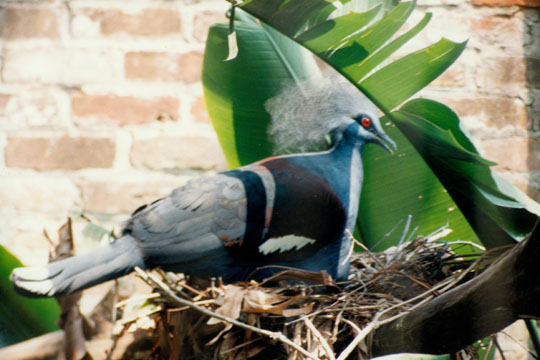 Fred photographed this colorful bird in one of the exhibit areas near the elephant house. I should have written down some of the information about what the bird is; most everything in the Zoo here was labeled. But I neglected to, so maybe you can discover what kind of bird this is. |
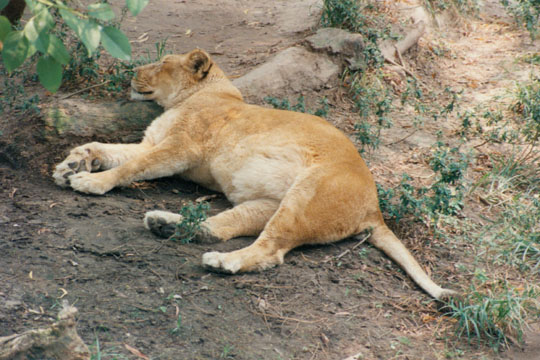 Fred brought his zoom lens with him and so got this great shot of a lioness relaxing. These big cats look so peaceful that you might almost think they would make great pets, or that you could walk right up to them and expect them to act like house cats. Probably a big mistake. |
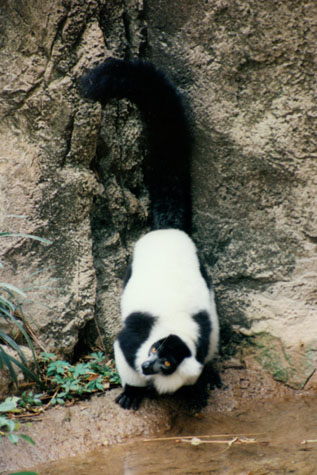 |
(Picture at left) Here is one of the many monkeys in one of the exhibits here at the zoo. Fred thought this monkey to be interesting, being the simian version of Chip and Dale. With his zoom lens, Fred is able to get wonderful pictures. We wandered around these African exhibits for a while, and then started walking over to some of the other exhibits.
(Picture at right)
|
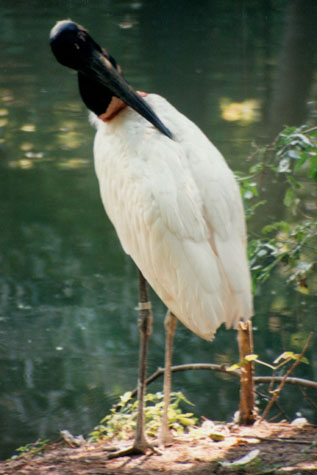 |
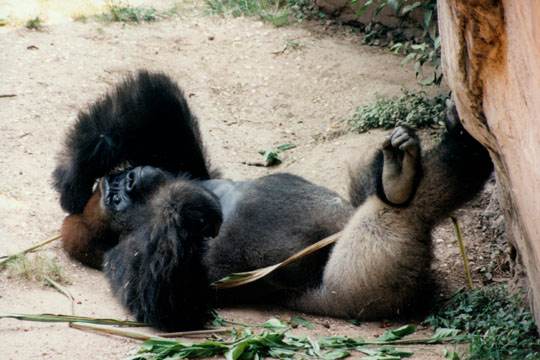 Fred took this picture at the gorilla house in the New Orleans Zoo; I had taken one also, but his is much better. It looked for all the world as if the gorilla had been out all night drinking, and was now trying to sleep off a bad hangover. He had his arm to his head as someone with a bad headache might, and just had that same look that someone who is drunk has. I expect, though, that the pose was due much more to the heat; the day was quite warm and muggy. |
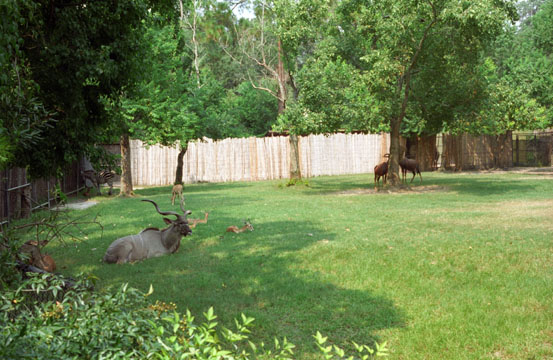 Here are some antelope, a zebra, and other animals. Many enclosures here contained a number of different animals; I guess that the only thing you have to worry about is getting predator and prey in the same spot. I suppose that it is pretty easy to tell which is which, and so mixing animals is not very difficult. Actually, the lions were kept some distance from here, which made me wonder if that was so their roars would not upset these animals who would be the lion's natural prey. |
I might interrupt these pictures of some of the animals that we saw at the Audubon Zoo with some pictures we took of each other.
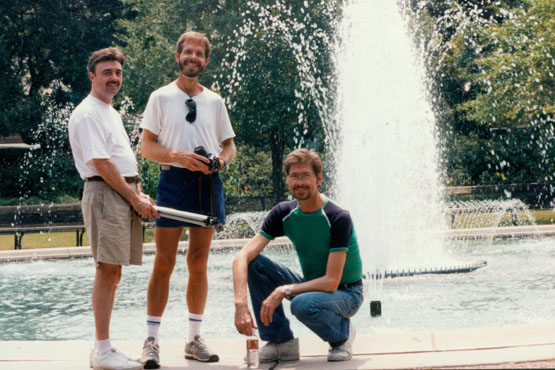 In about the center of the zoo there is a very nice fountain, which forms the backdrop for this picture that Fred took. I can tell that Lowery is getting a bit winded, but we are trying to take it slowly. |
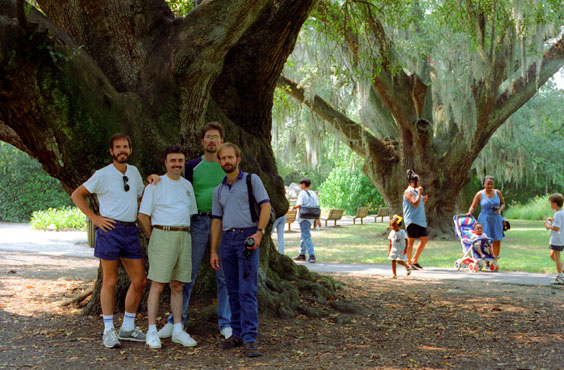 Lowery thought these huge trees with their burden of Spanish moss were very picturesque, so I decided to use them as a backdrop for this picture, taken using Fred's tripod. |
We went to the reptile house next; Lowery doesn't like snakes, but he went in anyway. It was cool inside the reptile house, and that was good for Lowery. He and Ron were able to find a place to sit down and rest. After that, we stopped for the first snack of the afternoon- tacos at the Zoo concession stand. The reptile theme continued outside where we found exhibits of turtles and tortoises:
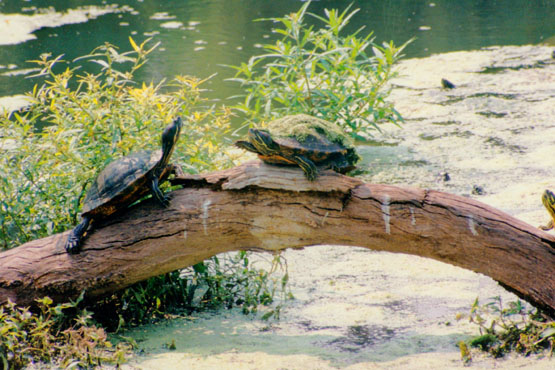 Here are some turtles sunning themselves by a small pond at the edge of the antelope enclosure. This small artificial pond is undoubtedly used as a watering hole for the other animals in the enclosure. In addition to that, though, it was full of turtles. You can see two of them here, in this zoom shot taken by Fred, and you can see another one swimming through the water in the background. |
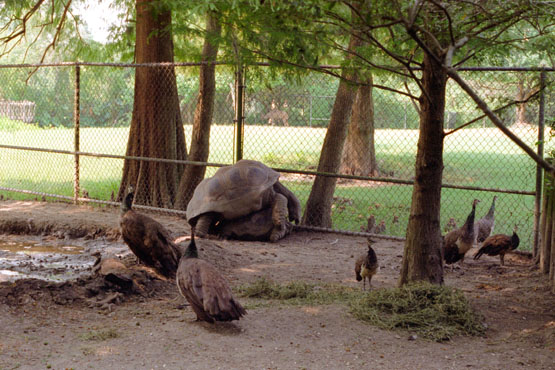 I guess you could say that now you've seen how tortoises "do it." I can't imagine that it is pleasant for the female, although I couldn't help but remark to a couple of people standing next to me that perhaps one of the other female tortoises in the enclosure might have been saying "I'll have what she's having!", although all the other tortoises seemed oblivious. |
Right about this time, I think Lowery had had enough of the walking around in the muggy heat; he and Ron decided to walk straight to the Zoo exit where you can catch the boat back downtown, and left Fred and I to see the rest of the Zoo. The Audubon Zoo is like the Dallas Zoo, but a bit smaller, I think. Nearby, there were exhibits that highlighted the terrain around this part of Louisiana, with alligators and other swamp creatures.
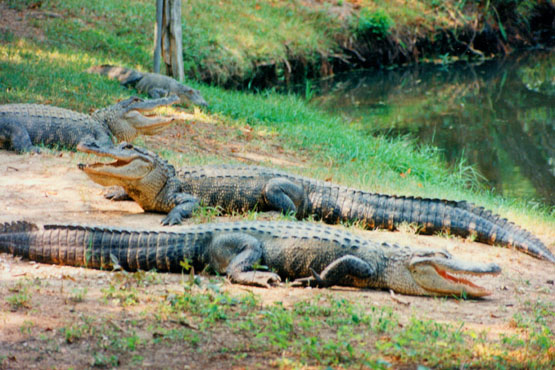 The Louisiana exhibit is like a real swamp, complete with some old shacks reached by what looks like a very old wooden walkway. Out in the middle of the swamp is a Cajun snack bar where we had some spicy meat pies that were delicious, and both of us had the Cajun equivalent of a snow cone. After munching that down, we spent some time watching the alligators; there were six or eight of them on this particular bank, all lying there with their mouths half open. |
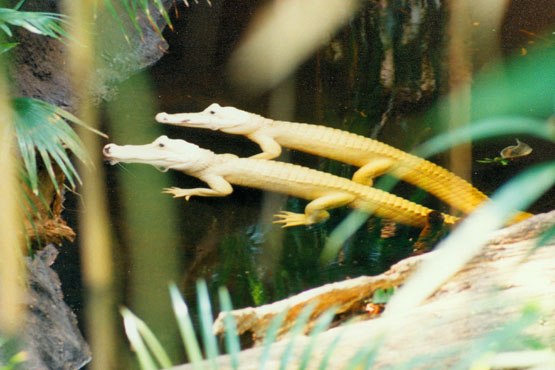 In 1987, an alligator nest was discovered in the swamp exhibit with 18 freshly hatched babies with white hides— an extraordinary natural mutation called leucism (they are not albino because they don't have pink eyes). They received much attention when they went on display and became a symbol of the zoo. These particular alligators were quite small; I would guess just a couple of feet long. Fred was able to get this good shot with his zoom lens. |
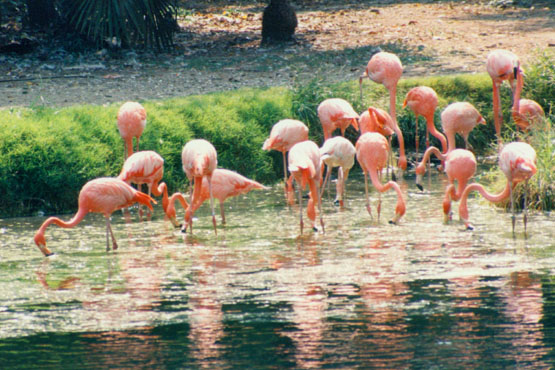 Of course there were flamingos here, and Fred got a nice picture of them with his long lens. You might remember that the Dallas Zoo had a similar section of birds, but I don't recall there being so many of these. They certainly are graceful in many ways, but very ungainly in others. I marvel at the wide variety of adaptation that nature has made in animal species, making each one perfectly adapted to its environment and its habits. The long legs and long necks were specifically designed so the bird could stand in water and feed on things in the water. |
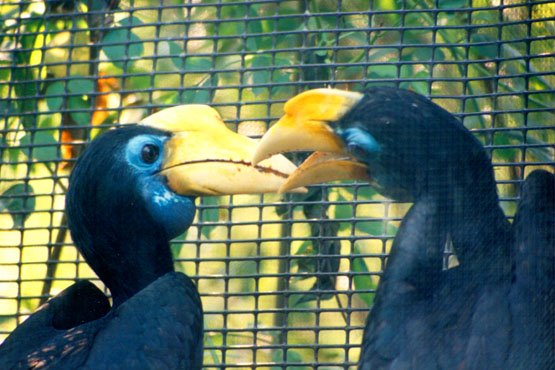 These are some toucans that we came across in an aviary here that was right next to the Australian outback exhibit as we were wandering through it. There were quite a few very interesting birds, including this pair. Obviously, this shot was also taken through the zoom lens. Right outside the aviary was a Koala bear, but I didn't take a picture of it because I didn't think it would stand out from its background. Fred didn't take one either, but I probably should have asked him too. We saw kangaroos, of course, but they are a common sight. |
We didn't want to spend a great deal of time here at the Zoo; after all, New Orleans Southern Decadence isn't about the normal sights in the city. So we began to head towards the exit to the Mississippi River.
|
We missed a good picture of a peccary (javelina); we saw a group of them between the Louisiana Swamp and the Australian Outback. On the way, we passed an area that held some of these wild pigs, and Fred took a close up with his zoom, but the animal moved just as the shot was taken, making it so fuzzy as to be unusable. In the same compound, there were some deer and other animals, none of whom, apparently, were predators of the others.
We did learn that in 1990, the Audubon Institute, which manages the zoo, opened the Aquarium of the Americas at the edge of the French Quarter. Some of the white alligators were transferred to there, and a riverboat began service taking visitors between the facilities. So that's what we thought we would do next, although we needed to see if Lowery and Ron wanted to join us.
When we were done at the Zoo, we headed for the same exit that Lowery and Ron had taken earlier, one that would lead us down to the dock for the James Audubon Steamboat, which would take us from the Zoo downtown to the Aquarium.
Our Ride on the James Audubon Steamboat
|
This boat seemed typical of cruise boats on rivers, like the Jungle Queen in Ft. Lauderdale or the boats on the Rhine. There's inside air-conditioned space, a snack bar, a bar, and plenty of seating. We chose to go right to the top of the ship, just forward of the funnel that you see sticking up at the stern of the ship.
On board, we discovered that you can use the steamboat without paying for the Zoo or the Aquarium, but if you do, there is a charge of $5 or so. I think it is a great idea, particularly if you've gotten tired walking through Audubon Park or the Zoo. You can also use the boat to get to the Zoo, but we did not know that this morning. Anyway, we wanted to ride the streetcar.
The boat pulled away from its dock right at 5PM, turned downstream and began the three mile trip to its dock near the Aquarium downtown. We had a chance to relax, have a drink, and watch the Mississippi River scenery roll by.
|
Actually, I would think the mud would just pile up next to the same type of docks further downstream, just adding to someone else's problem, but maybe it doesn't. Anyway, I assume the red boats are powering the dredging operation, and you can see the pipes bringing the slurry out into the center of the river.
As have many cities and towns, New Orleans has made use of its natural resources, in this case the river itself. A riverwalk has been built near the downtown area and along the river, and this riverwalk contains the obligatory shops and tourist attractions. We never went into it, for we assumed that it would be much like The Riverwalk in San Antonio, or perhaps the bayside shopping center that Ty, Scott, and I have been to in Miami.
|
Only a few companies have, as yet, gotten licenses for land-based casinos. There are one or two in Shreveport and Bossier City, and the new Harrah's here in New Orleans. We plan to visit the current site of Harrah's tomorrow. This whole area of riverfront has been completely redone in the past few years, and certainly I don't remember any of it from my trips here in 1984.
Fred and I left the boat and walked through the French Quarter to the Prince Conti hotel to get back together with Ron and Lowery. On the way, we found a delightful candy store to patronize. Already, on this Saturday afternoon, Bourbon Street was filling up with people.
|
For dinner, we went to the Palm Court restaurant that has a live jazz band. Fred and Prudence had been there before, and he recommended it highly. It was quite good, though a bit expensive. Most of us had creole dishes, although Lowery stuck to a pasta based dish. My shrimp creole was wonderful; Ron Drew had jambalaya, and Fred had a seafood dish. We shared, naturally. The music was loud at times, but not irritatingly so.
After dinner, we all walked around a while until Ron and Lowery returned to the hotel, and Fred and I stayed out rather late in the area around the bars. More frozen drinks and more people watching.
The Audubon Aquarium of the Americas
|
As its name implies, the aquarium specializes in the aquatic life of the Americas. The exhibits feature regions throughout North and South America. With 10,000 animals representing 530 species, noteworthy exhibits include:
|
The Caribbean reef exhibit featuring a clear, 30-foot-long tunnel surrounded by a 132,000 gallon tank of exemplary sea life such as the tarpon and angelfish The Amazon exhibit, encased in a glass cylinder, effectively a humid, climate-controlled greenhouse that is a prominent feature of the riverfront and includes macaws, piranhas, an anaconda, freshwater stingrays, and other specimens from the area basin The Mississippi River gallery, featuring catfish, paddlefish, owls and a leucistic white alligator The Gulf of Mexico exhibit, featuring a 400,000 gallon, 17-foot-tall tank of sharks, sea turtles, and stingrays |
The aquarium is also home to an IMAX theatre and exhibits of sea otters and African penguins. After we had our small breakfast, we took a cab down to the aquarium.
|
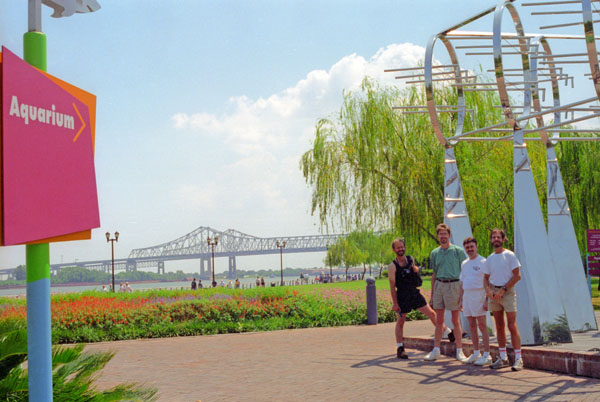 |
The day was already quite warm and humid, and so it was nice when we entered the Aquarium. Once inside, we walked right in past the ticket line, having bought our tickets at the Zoo the day before. The aquarium was very interesting, and there was lots to see. What I'll do here is just include some of the best of the pictures we took inside. You enter through a tunnel that goes right through a very large fish tank. After passing through the tunnel, which is entirely of glass, allowing you to look in all directions inside the tank, you are in a large, multi-story atrium that provides access to the exhibit areas.
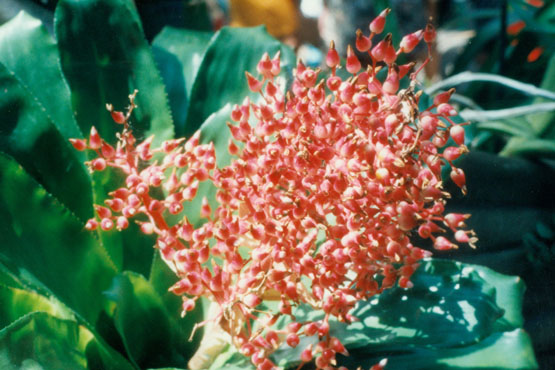 The Aquarium housed not only a wide variety of marine life, but also a veritable greenhouse of plants and flowers inside the aquarium building, in a multi-story atrium. |
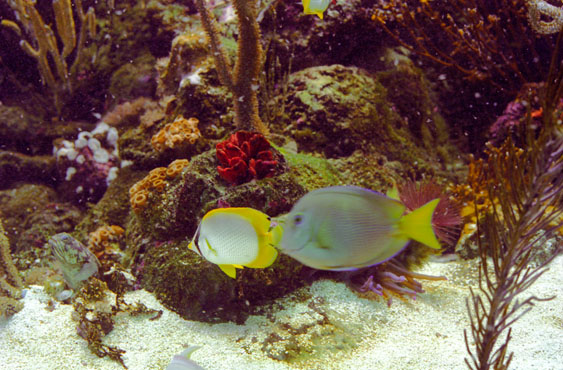 This is typical of the fish tanks that we found inside the Aquarium. I thought the exhibits and the inside of the tanks were all very well done. |
I particularly liked the exhibits on alligators and sharks, and of course, the feeding exhibition in the main tank. Not only were there a multitude of fish species to look at, but various sea plants as well. In one tank, there were a number of kinds of coral and a good many starfish (the latter in a shadowy area that wouldn't have been good for a picture). I was constantly amazed at the great variety of fish that there are, and all the different colors and shapes.
|
|
One episode explored how water would affect coastal cities, and of course New Orleans was one city featured prominently. I am writing this narrative post-Katrina (2005) so the producers of the series already had some evidence of what would, indeed, happen. Three clips from the episode featured the Aquarium, and I thought you might be interested in watching them. The first clip is at left; just hit the play button to watch it.
Since the clip above talked in detail about the fish tanks at the Aquarium, you might like to see a couple of the pictures we took of the more colorful of them:
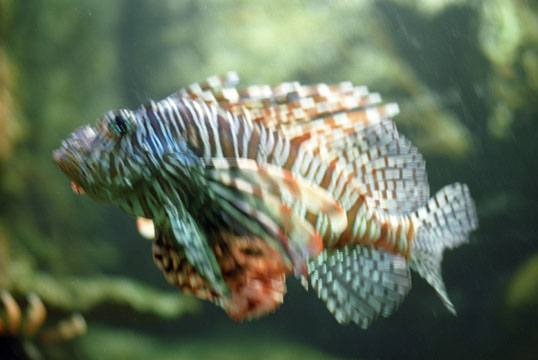 There was low light for this shot, so I was having to try to "track" the fish with the camera as it was swimming past. I didn't do such a good job, though. |
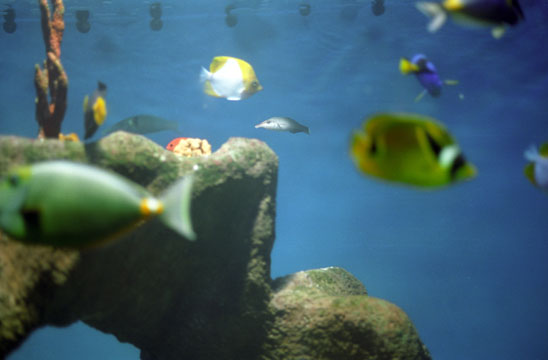 This shot didn't turn out as well as I had hoped; the fish were swimming just too fast for the shutter speed that I was having to use to maximize the light available. |
You can use the player below to watch the second clip from "Life After People" to continue the story of what might happen to the Audubon Aquarium were all the staff to disappear. It's a little morbid, but very interesting:
Thankfully, we saw the Aquarium when all its staff was present and taking care of the facility, and they were doing a great job. Here are the last to pictures we took inside:
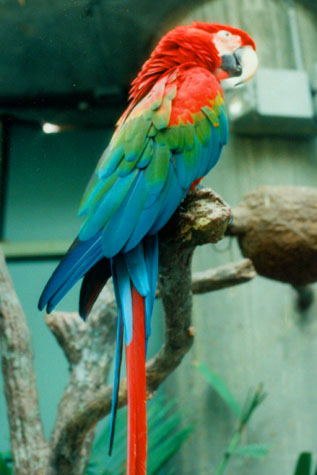 A Colorful Parrot |
(Picture at left) In one area of the aquarium there are a number of large parrots. These birds are able to fly around the inside of the building, but I guess they just stay perched in their own particular area. There are some indoor trees and such for them to inhabit, but the building is big enough that they could move around easily. I won't try to detail all the exhibits that we saw; just imagine everything associated with fish or with the Gulf of Mexico.
(Picture at right)
|
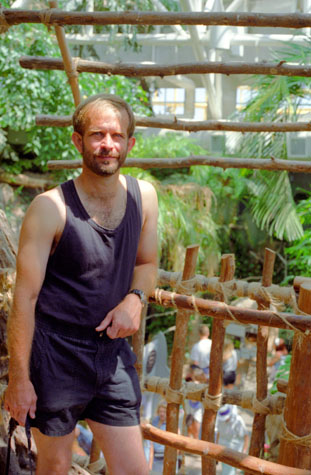 Fred in the Aquarium Atrium |
As you learned in the clip above, the aquarium lost almost all of its fish in the days following Hurricane Katrina. Though the facility was mostly undamagted, the sophisticated systems that kept the animals alive failed for too long a period. The Aquarium did not reopen until May 26, 2006, almost a year later. Of course, New Orleans itself has never completely recovered.
|
|
By the way, that last clip noted that while almost all of the animals in the Aquarium were able to survive the first week or so without electricity, only one of them would have still been alive a year later. If you would like to find out which Aquarium occupant that would have been, you can watch the last clip at left.
We spent about two hours in the aquarium, and then went out front to the river to take some more pictures.
The New Orleans Riverfront
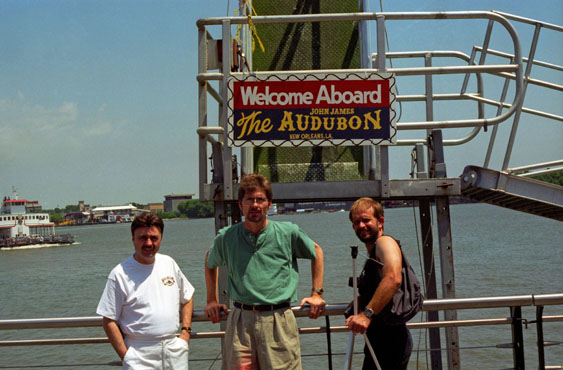 Here are Ron, Lowery and Fred at the boarding dock for the Zoo cruise in front of the New Orleans Aquarium. It is indeed quite hot and humid, which adds to everyone's feeling uncomfortable. When we returned from the zoo yesterday on the riverboat, this is where it docked. |
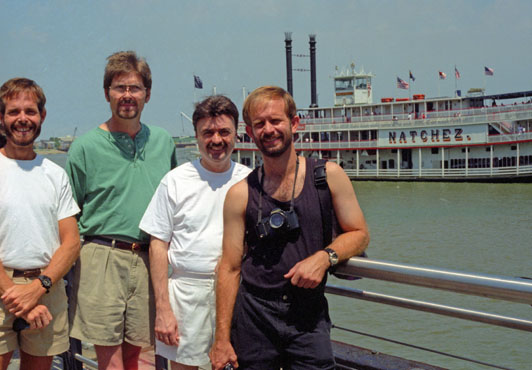 Here are all of us on the New Orleans riverfront. One of the large paddle-wheel steamers on the river is just passing behind us, and I thought this would be a good opportunity for a picture of the four of us. Unfortunately, I chopped myself off. |
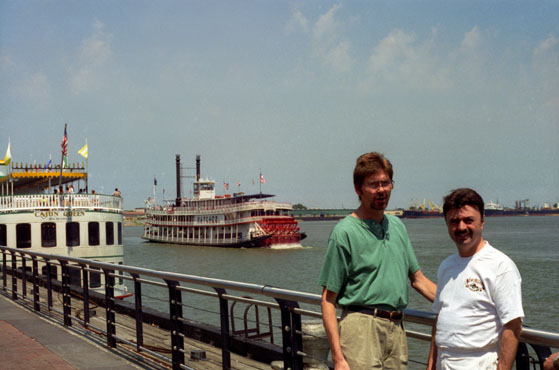 Here are Lowery and Ron at the New Orleans riverfront just outside the New Orleans Aquarium. The steamer has just passed us by, and this was my opportunity to get the whole boat in the picture. |
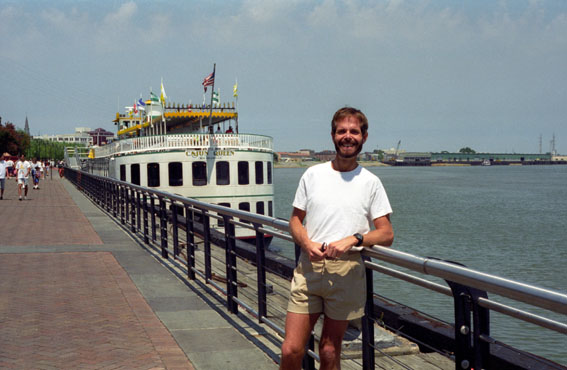 Behind me is the Cajun Queen, one of the many riverboats that ferry passengers up and down. It was getting ready to leave for a day cruise. The river curves out of the picture to the right behind me. |
In addition to the pictures above, Fred had his panoramic camera with him, and while we were here at the riverfront, he took a series of panoramic images. Not all of them turned out amazingly well, and some of the duplicate the views we took with our standard cameras, but you might want to see them nevertheless. You can look at any or all of them by simply clicking on the small thumbnail images below:
 |
This being a weekend, and Labor Day at that, there was not a great deal of river traffic, but I imagine that there normally is. From the riverfront, we headed back towards the center of the French Quarter to have a look at what was going on in connection with Southern Decadence.
|
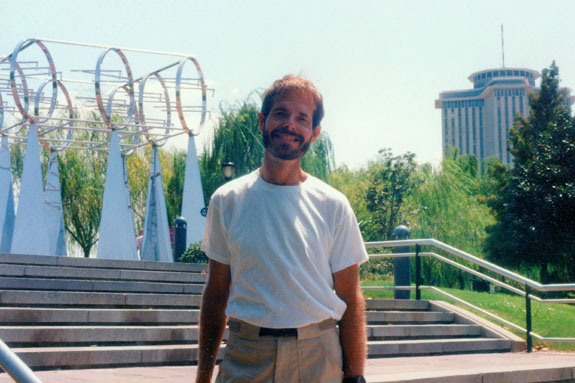 |
The French Quarter and Southern Decadence
Southern Decadence traces its beginnings to August 1972, at a party among a group of 40–50 friends. They billed their event as "Southern Decadence Party: Come As Your Favorite Southern Decadent." People who attended were required to dress as their favorite decadent Southerner. The first small "parade" occurred the following year, when the participants first met at a bar in the French Quarter to show off their costumes and then walk back home along Esplanade Avenue.
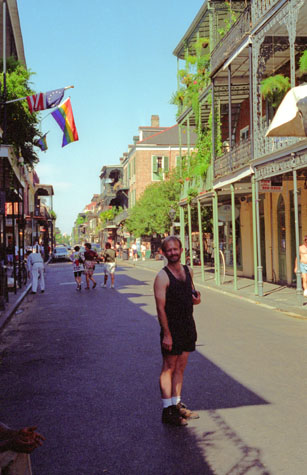 Fred in the French Quarter |
(Picture at left) The wrought iron work is typical of the architecture and design of the French Quarter- with its roots in the late nineteenth century. I can certainly picture how this area must have looked between the Civil War and the turn of the century. We have come down to this part of the French Quarter so Fred could look through a shop that sold Southwest stuff. We both found a couple of knickknacks. I got some glasses that had been turned into candles commemorating the white buffalo, and gave them to Fred.
|
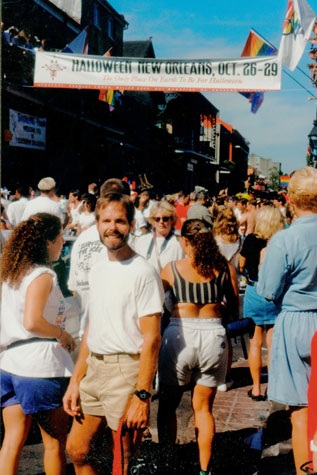 On Bourbon Street |
This first group impersonated people and characters ranging from Belle Watling (the prostitute character in Gone With the Wind) and Mary Ann Mobley to Tallulah Bankhead and Helen Keller. The event expanded, with the first Grand Marshal of the event appointed by members of the original group in 1974.
|
The view below of a very typical street in the French Quarter looks east towards where the Convention Center and Harrah's Casino.
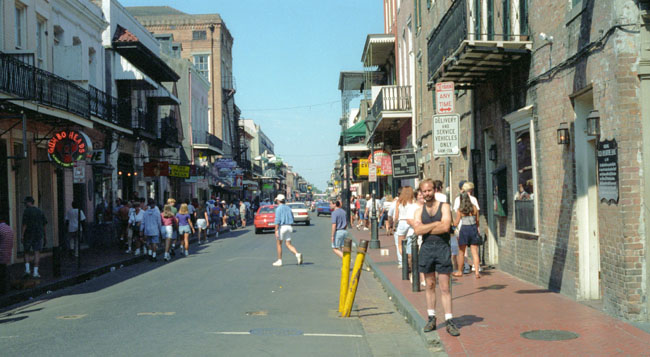 |
When we got into the thick of Southern Decadence, I learned again how Fred and Ron are very much alike in at least one respect- they both like to look. Not that I don’t, but I tire of it much sooner than they do. In this respect, I am more like Lowery. But we were all having a good time with the crowds, the costumes, and the shameless exhibitionism.
|
Decadence, as it is commonly known by participants, is marked by parades, bead tossing, street parties and dance parties. In these ways it resembles New Orleans Mardi Gras, however, Southern Decadence tends to be more sexual in tone and is generally geared towards more upscale and mature revelers. Decadence crowds in the Quarter typically match or exceed Mardi Gras crowds. Most events take place in or around the French Quarter neighborhood, centered at the intersection of Bourbon and St. Ann streets.
Crowds range from 100,000 to 200,000 revelers from across the nation and world; I believe that someone at the Hotel told me that the city expected some 180,000 this year. I learned later that the city estimates a positive economic impact of about $150 million each year from the event.
Themes were presented on and off from the beginning, but did not become a consistent fixture of the event until "Circus Came To Town" theme in 1990. They have been featured every year that the Decadence has been held since then. They have ranged from themes as varied as "Voodoo That You Do", "Menage a Trois", "Ancient Truths, Lies, and Sacrifice", and "HURRICANE: This Year, They Blow Back." This year's theme, quite unintelligible to me, was "Tour of da'NILE!".
|
One of the customs at Southern Decadence is that revelers on balconies toss strings of cheap beads down to those they find attractive, or who "work" for the beads in some way. Nominally, one gets beads for displaying certain body parts (there being a scale of how many beads and how nice a string are thrown for each body part, and I will leave that to your imagination), and there are lots of takers.
Lots of beads were being thrown this afternoon to whomever the men on the balcony found attractive or interesting. It is something of a status symbol to return from New Orleans with a whole neck full of beads, even though, according to the usual custom, that just means that you are basically an exhibitionist. I recall once that our friend Justin came back with almost a hundred strings of beads a couple of years ago. But then, if you knew Justin, you'd ask "Is that all?"
Actually, I was able to catch one string of beads (probably not thrown to me), and then later recounted to Lowery and Ron just what it was that Fred had to do to get them.
|
|
We dropped Lowery by the hotel, and Ron, Fred and I walked over to the Harrah's Casino in the old convention center. It was very typical, although it looked very much like a converted convention center. We played the slot machines and walked around for a bit. I lost $4, Ron lost $5, and Fred won $20. I'll have to remember to never bet against him.
We walked back to the hotel so Ron could rest before dinner, and Fred and I went out walking some more.
That evening, for dinner, we went to a restaurant Lowery had heard about where all the waitresses were actually drag queens. We all expected it to be as much of a show as a restaurant, but we were a bit disappointed. Yes, the drag queens were well done up, but they acted very blasé, and just like waitresses. Furthermore, the service was terrible and it took an hour to get fed.
While we were waiting for our food, an attractive, bearded man came in and stood near our table at the entrance as the headwaiter told him it would be an hour before he could be seated. When the guy left to wait in the bar, we started wondering about his ethnic background, and the four of us had four opinions. On the spur of the moment, I got up and went into the bar, introduced myself, apologized for being forward, and asked him his heritage, which turned out to be French Cajun. Then, also on the spur of the moment, I invited him to join our table. Surprisingly, he did, providing some interesting dinner conversation, and his order came not long after ours. His name was Mark, he was a graphics designer from Houston, and he turned out to be a very nice guy. We all enjoyed someone new to talk to during the meal.
Jackson Square
|
At left is the view from our room at the Prince Conti. You don't get a hotel room in the French Quarter for the view, as this picture of Fred's indicates. Even so, our view was much better that Lowery and Ron's.
I guess the French Quarter hasn't changed much, although I suppose that many of the buildings have been very much renovated on the inside, as our hotel has. We had breakfast again with Lowery and Ron, but both of them were tired and wanted to just remain in the hotel until it was time to leave for the airport at one o'clock. Fred and I packed up our things, checked out, and then decided to walk down to Jackson Square by the river. Fred knew that there were a couple of museums there, and we hoped they might be open on Labor Day.
Jackson Square is a historic park in the French Quarter. It was declared a National Historic Landmark in 1960, for its central role in the city's history, and as the site where in 1803 Louisiana was made United States territory pursuant to the Louisiana Purchase. In 2012 the American Planning Association designated Jackson Square as one of America’s Great Public Spaces.
|
Sculptor Clark Mills' equestrian statue of Andrew Jackson, Battle of New Orleans hero and U.S. President for whom the former military parade ground was named, was erected in 1856. Iron fences, walkways, benches, and Parisian-style landscaping remain intact from the original design by Micaela Almonester, Baroness de Pontalba, in 1851. She also built the Pontalba Buildings, which flank the old square.
The flagpole, symbolizing the 1803 ceremonial transfers from Spain to France and then from France to the United States, reflects Louisiana's rich colonial history. During the 1930s, the Works Progress Administration (WPA) repainted façades, renovated buildings, and improved landscaping in and around the park. In 1971, the pedestrian zone in the vicinity of Jackson Square was created, when three surrounding streets were closed to vehicular traffic — Chartres, St. Peter, and St. Ann.
To get to Jackson Square from the hotel all we had to do was walk about four blocks southeast on Toulouse Street (the street on which our hotel was located) and then one block northeast on Chartres Street. This brought us to the western corner of the square (the streets bounding the square run northwest-southeast and southwest-northeast; that puts the corners of the square on the compass points).
|
At that corner, I took the picture at left of Fred in front of one of the museums. It was a shame that the museums were closed, because I am sure they would have been interesting. The square is just that- a small square park right across the street from the river. Around the square, there are people who have set up shop to sell artwork, do caricatures, perform, read palms, and so on. We wandered around there for a while, and in and out of the shops bordering the square.
In this picture of Fred, which shows the north side of the square, you can see two of three 18th-century historic buildings, which were the city's heart in the colonial era. At the left, out of the picture, is the Cabildo, the old city hall, now a museum, where the final version of the Louisiana Purchase was signed. At left in the actual picture is the St. Louis Cathedral. The cathedral was designated as a minor Basilica by Pope Paul VI. To the cathedral's right is the Presbytère, built to match the Cabildo. The Presbytère was initially planned for housing the city's Roman Catholic priests and other church officials. At the start of the 19th century, it was adapted as a courthouse, and in the 20th century it became a museum.
Early French colonial New Orleans was centered on what was then called the Place d'Armes (literally, "weapons' square"). Under Spanish colonial administration in the second half of the 18th century, the name was Plaza de Armas.
Following the 1815 Battle of New Orleans, during the first half of the 19th century, the former military plaza was renamed Jackson Square, for the battle's victorious General Jackson. In the center of the park stands an equestrian statue of Andrew Jackson erected in 1856, one of four identical statues in the U.S. by the sculptor Clark Mills. The square also has 4 slightly older statues, neoclassical representations of personifications of the 4 Seasons, one near each corner of the square.
The square originally overlooked the Mississippi River across Decatur Street, but the view was blocked in the 19th century by the construction of higher levees. The riverfront was long devoted to shipping docks. The 20th-century administration of Mayor Moon Landrieu installed a scenic boardwalk on top of the levee to reconnect the city to the river; it is known as the "Moon Walk" in his honor, and has since been expanded and paved. The space between Decatur Street and the "Moon Walk" is designated as "Washington Artillery Park".
|
The Place d'Armes was the site for public execution of criminals and rebellious slaves during the 18th and early 19th centuries. After the 1811 German Coast Uprising, three slaves were hanged here. The heads of some of the executed rebels were put on the city's gates. (The same thing happened in St. Charles Parish, and a third slave-trial tribunal was held in St. John the Baptist Parish.)
In the Reconstruction Era, Jackson Square served as an arsenal. During the insurrection following the disputed 1872 gubernatorial election, in March 1873, it was the site of the Battle of Jackson Square. A several-thousand-man militia under John McEnery, the Democratic claimant to the office of the Governor, defeated the New Orleans militia, seizing control of the state's buildings and armory for a few days. They retreated before the arrival of Federal forces, which temporarily re-established order.
From the 1920s through the 1980s the square was famous as a gathering place of painters of widely varying talents, including proficient professionals, talented young art students, amateurs, and caricaturists. The 1960s and 1970s saw the beginnings of the Square as a place of business for New Age and pagan devotees telling fortunes and reading palms and tarot cards. They sit on St. Ann or St. Peter street, alongside of the park. Chartres Street, in front of Saint Louis Cathedral, the Presbytère, and the Cabildo, is shared by visitors and artists, musicians, and varied street performers, such as jugglers and magicians. The performers generally work for tips.
|
Three Roman Catholic churches have stood on this site since 1718. The first was a crude wooden structure in the early days of the colony. Construction of a larger brick and timber church was begun in 1725 and was completed in 1727; it was destroyed in the Great New Orleans Fire in 1788. The cornerstone of a new church was laid in 1789 and the building was completed in 1794. In 1793 Saint Louis Church was elevated to cathedral rank as the See of the Diocese of New Orleans, making it one of the oldest cathedrals in the United States. In 1819, a central tower with the clock and bell was added.
However, very little of the 1819 structure still exists, although the Cathedral was never again entirely destroyed or rebuilt. Beginning in 1834, plans were being thought out to expand the size of the building, and J. N. B. de Pouilly was engaged to design plans for the expansion. In 1849, the diocese contracted with John Patrick Kirwan to enlarge and restore the cathedral, using De Pouilly's plans.
These plans specified that everything except the lateral walls and the lower portions of the existing towers on the front facade be demolished but during the reconstruction, it was determined that the sidewalls would have to be demolished also. Then, during construction in 1850, the central tower collapsed. De Pouilly and Kirwan were fired, but, as a consequence, very little of the Spanish Colonial structure survived. The present structure primarily dates to that year, although the bell from the 1819 tower was reused in the new building.
We walked out into the center of the park to have a look at the statuary.
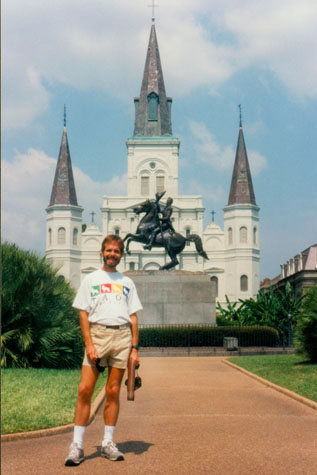 Jackson Square and Cathedral |
(Picture at left) The statue of Andrew Jackson is in the middle of the square and the Cathedral is in the background. From the center of the square, we walked over to the river to look around there, and that is where the next picture was taken.
(Picture at right)
|
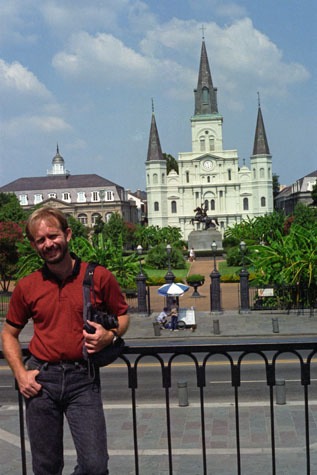 Fred and Jackson Square |
In addition to the pictures above, Fred took a nice panoramic shot of me with Jackson Square in the background:
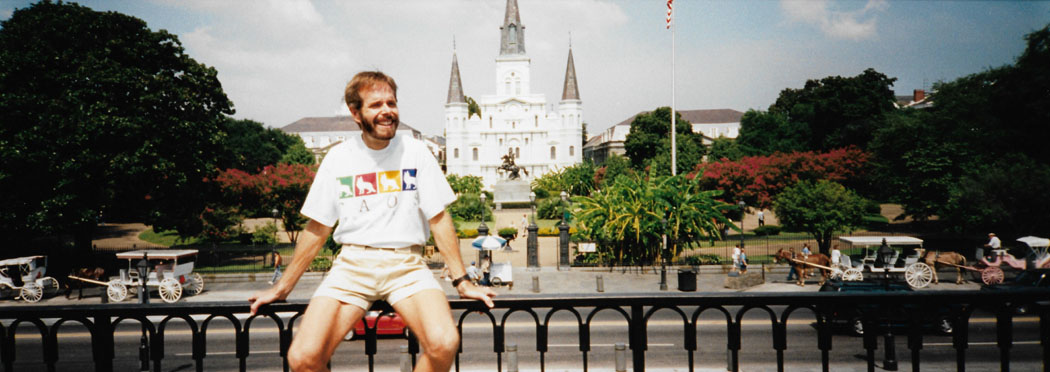 |
Walking around Jackson Square was tiring because this was the hottest and most humid morning yet of our trip. After a while, we started back to the Prince Conti to collect Ron and Lowery.
|
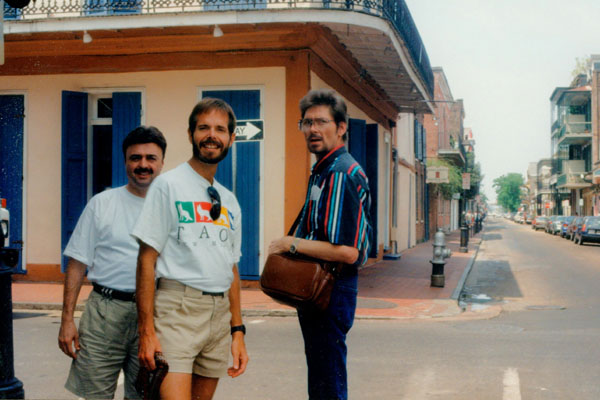 |
Lowery was tired after not having slept well, and I think he was ready to get home and recuperate. The cab came right on time. At the airport, Lowery and Ron boarded early and saved seats for Fred and I, so we all sat together on the way home. At Love Field, Jeffie came over to pick us up, and Lowery and Ron had their car there, so we parted company. Jeffie dropped us off at the house, and we cleaned up and got ready to go up to Ron Mathis' house for dinner and cards. We spent the evening there, and then both Fred and I went on up to his house in Van Alstyne. I returned to Dallas on Tuesday morning, and then spent that evening with Lowery and Ron at their house. The New Orleans trip was a lot of fun, and I'm glad that Lowery felt like doing it.
You can use the links below to continue to another photo album page.
 |
September 24, 1995: The Dallas Gay Pride Parade |
 |
July 19 - August 10, 1995: My Trip to North Carolina and Florida |
 |
Return to the Index for 1995 |